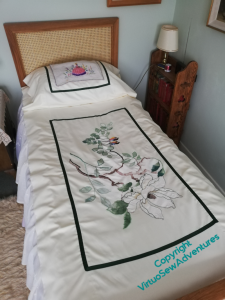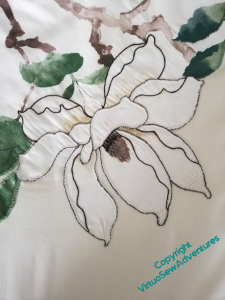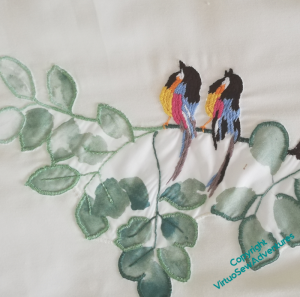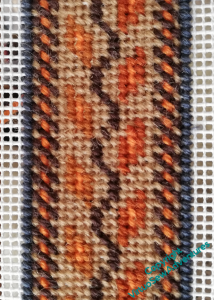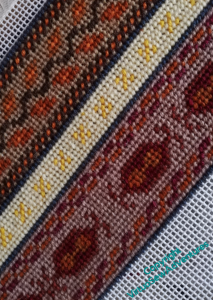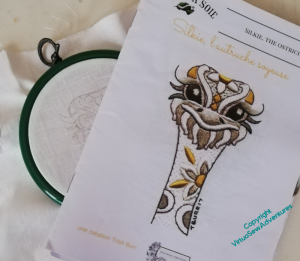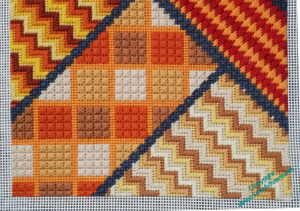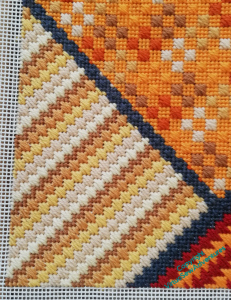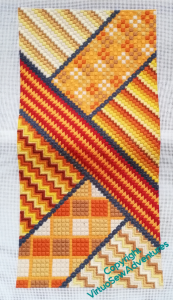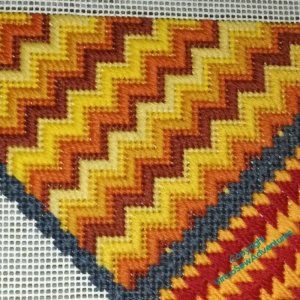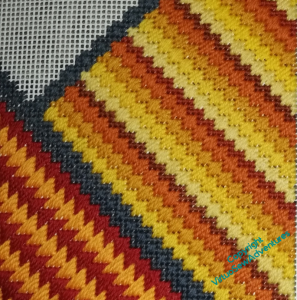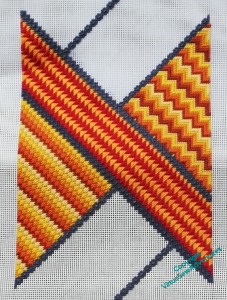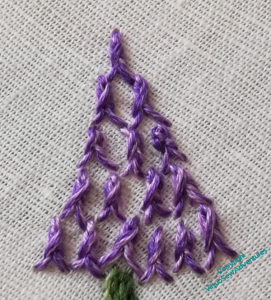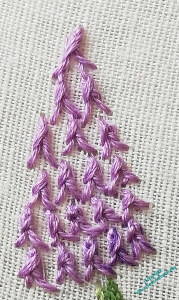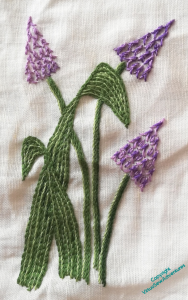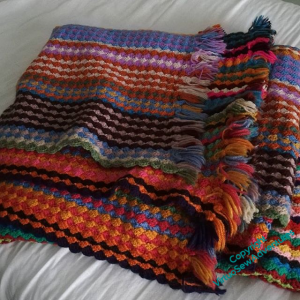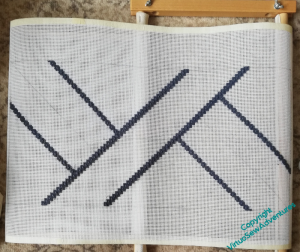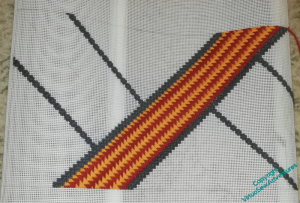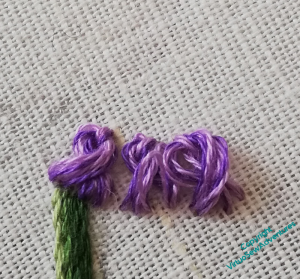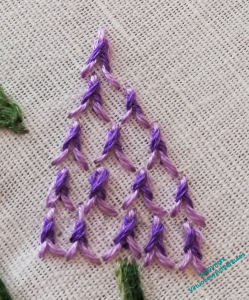Category: General Embroidery
A Finish To Celebrate (not mine!)
You may recall that my mother was embroidering details and edgings on an appliqu bedcover for herself.
It’s finished!
The slightly more marked colours and edgings make sense of it as a response to the curtains, rather than a random slice of curtain material, and the crisp green ribbon frame confines and sets it off rather nicely.
She occasionally asked for my advice, but I can’t say she needed it. This is the only point, I think, at which I made a material contribution to the finished piece. The fabric was lamentably keen to fray, so all raw edges needed covering, and this large flower would have looked very clunky with dark blanket stitch.
White blanket stitch, whipped along the outside edge, however – that worked!
The stitching for the birds was inspired by something Grandmama did, and does look quite feathery, somehow.
It’s always satisfying when a plan comes together, even when it isn’t one of mine!
Returning to my projects, however, Episode 46 of Slow TV Stitchery is now live, in which are discussed the Delights of Stash and the Perils of OverEngineering.
More on Silkie The Ostrich
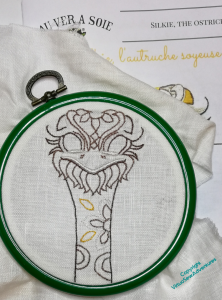
I got started on the design by doing the split stitch, partly to cover the design lines, and partly because I find it easier to maintain interest if the design advances all over, rather than in spots. That’s why I did all the stems first when I did the Coat of Many Flowers!
The next element, with the white silk from outlining still in the needle, was to tackle the padded satin stitch around the beak and beneath the eyes.
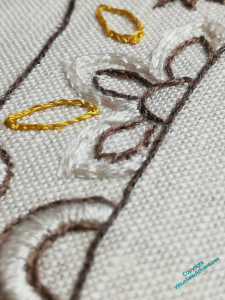
After that I moved on to the decorations on the neck. The patterns are picked out in padded satin stitch. Of course, I decided to complicate matters for myself, and I have decided to vary the levels of padding, and the placement of the padding. For example, I hope you can see here that the padding on the white petals of the flower is shifted to the outside of the petals, and has been done in a couple of layers.
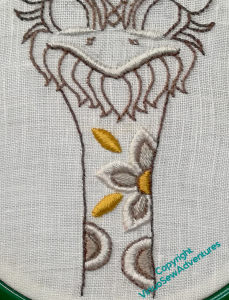
When it came to the two golden leaf shapes, I combined two layers of chain stitch padding with a layer of satin stitch at right angles to the final layer.
The light grey elements are all unpadded.
I’m not sure that it shows at all well, but it does make more of a difference in person than in reproduction!
Meanwhile, Episode 45 is now live – in which I continue planning Placidus, while considering the challenges of image searches, and the occasional opacity of musical jokes.
More Stash Busting
In the clearest demonstration yet – at least in embroidery terms – that we are in the End Times, I have embarked on some stash busting counted tent stitch.
I rather enjoyed working on the Stash Busting Footstool, and there was a bit of canvas left on the frame when I’d made it, so I reattached the cut end, rifled through what was left of the tapestry wool, and started to play.
Since I don’t know how far my wools will stretch, my sole “design” is to take the idea of making a fabric from ornamental ribbons, alternating broad and narrow.
This vine pattern is based on one in “Needlepoint” from Ebury Press.
The next two “ribbons” I made up as I went along – one narrow, light pattern in two shades of yellow, and another broad one, this one distinctly made-up-as-I-went-along. It was very vaguely inspired by another in “Needlepoint”, which in turn claimed to be inspired by a Persian pattern. I have my doubts, but in any case, even when I tried to have a sensible pattern of spacing, I ended up with something of a mishmash.
You may have noticed that the “neutral” in the two broad stripes is not the same colour. I’m going to try to alternate these as backgrounds, unless and until I start to need to blend them together to fill the space.
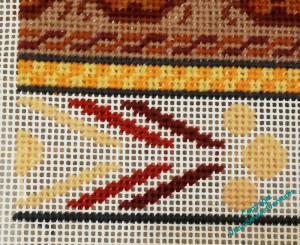
The next, narrow, band, is a chequerboard.
I like the stripe part of this next pattern, but after working the baubles, I looked again and decided that they weren’t quite working. I was trying for a mix of shapes, a bit of variety, and something to change the spacing of the stripes, but not this!
And while you assimilate the shock of me happily doing counted work – Episode 44 of Slow TV Stitchery is now live. In which we discuss the EES as an early crowd-funded organisation, my ambitions to hold a Dreams of Amarna exhibition, and whether “medieval muddle” is an idea purely from 19th Century northern Europe.
A rather belated start..
Some of you may recall that a year ago I worked Tanya Bentham‘s kit of the Hounds in the period between Christmas and New Year, as a change of scale, material, and subject while my bigger projects were tucked away to make space for decorations. You may also recall that I bought a Trish Burr design, “Silkie The Ostrich”, from Au Ver A Soie, to fill the same space in the turn of last year to this. And you may have been wondering why you hadn’t seen it yet…
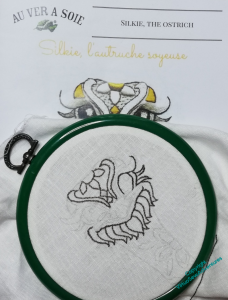
Well, it took two goes to get the design transferred, for a start! When I tried at home, using the low-tech sunlight-through-the-window technique, there wasn’t enough sunlight! So I had to wash off the failed version and use my mother’s rather fabulous LED lightbox (we’re in a bubble, so no, it didn’t involve breaking lockdown rules).
The more I invent and develop my own designs, the stranger it feels to follow instructions. This is still stranger, because the instructions are in French. I do speak French, but I didn’t do any embroidery when I lived there, so I don’t have any embroidery vocabulary. Not the least of the oddities of advancing years is finding which weird thing you couldn’t possibly have second-guessed you wish past-you had done…
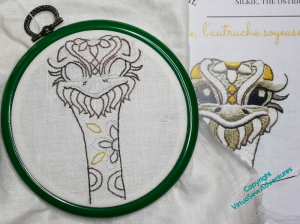
In this case, partly because I’m concerned about losing my design lines, I’m not following the order of working in the booklet of instructions. I’ve started by working all of the split stitch outlining. It’s all in a single strand of silk, so it’s questionable as to how much of a rest from my other projects this will give me, but I lost my heart to Silkie’s smile the moment I saw it, so I think it will be a rest in a different sense.
We have reached Episode 43 of SlowTVStitchery, a rather short episode, owing to some difficulties with camera focus. I was beginning to tackle the full width of the piece, while pondering the challenges posed by Brahms and Messien, and the lectures given for Gresham College by the late Christopher Hogwood.
The Stash Busting Footstool, 4
After a bit of thought and discussion, my mother suggested that for the last two panels, I should consider doing the same as on the far side of the central panel, but in a different set of colours. I had wanted to lighten the colours as they came away from the central panel, so that’s the scheme I used to pick the colours.
That, and making sure that I thought I would have enough of each colour to do both panels!
I then made things slightly harder for myself by deciding to line up the stripes across the central panels, but it was definitely worth doing. As I’ve said before, when upcycling, mending, or dealing with slightly not-entirely-planned projects, the whole secret is to make it all look deliberately planned – that’s why my mending tends to be embellished in a variety of ways.
Here is the finished canvaswork.
Actually, it isn’t. When I took it off the frame and took it to meet the footstool it’s intended for, I found it was an inch too short, in spite of what I believed to have been some careful measuring.
Clearly not careful enough!
I’m going to add half an inch to each end, and then consider the next step!
In other news, Episode 42 of Slow TV Stitchery is now live. In which I think I may have got to grips with the pattern, consider the adventures of Sir John de Mandeville, and consider the question of Music To Stitch To…
Stash Busting Canvaswork Footstool – 3
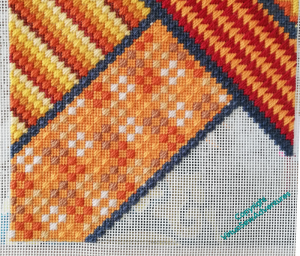
The notion that was guiding me – apart from stash busting – was of the colours getting lighter as they spiral out from the central point on either side of the central bar. So I picked more colours that I had enough of (see the constant balancing act I was involved in here?), and this time, stitch patterns which were squarish, rather than stripy. This is Checquer Stitch, and somehow by the time I’d finished the alternation of the colours, I ended up with something that rather reminded me of a Welsh Tapestry blanket. I’m happy with that – I was born in Wales, after all!
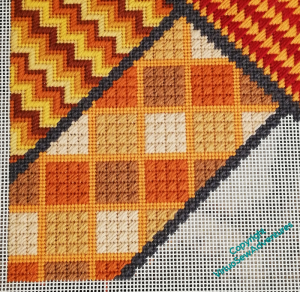
The balancing panel is even squarer. I suppose it is another variant – rather as with the Moorish Stitch Variation, I’ve moved all the tent stitches to the edges to form a grid. I think it still has enough family resemblence both to the original stitch and to the “Welsh Tapestry” version to balance them.
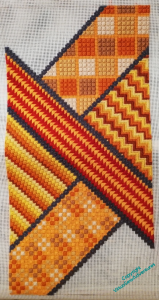
So here is stage two completed.
I think the balance and harmony I’m trying to create really are still there, but I feel as though I’ve rather shot my bolt. I’ve mislaid my canvaswork books and I can’t think of another suitable pair of diagonal stitches to use.
However, the first thing to do is to find a suitable set of colours. Onward, ever onward!
In the meantime, Epsiode 41 of SlowTV Stitchery is now live. A fairly quiet episode, this, which nonetheless discusses musical deceleration and taking refuge in learning things, while also anticipating the enjoyment of a Holiday Project.
Stash Busting Canvaswork Footstool -2
As this is a strictly stash-busting exercise, and I wanted to balance the colours across the central bar, I started by finding the colours I had two skeins of, and putting them in order of intensity. This is Jacquard Stitch, but where the classical colour patterning is one colour for the broad stripes and another for the tent stitch, here I have simply cycled through the colours, so that each colour has a chance at both stripes.
On the other side of the central bar, the same colours, but this time in a variant of Moorish Stitch. I felt the same pattern of colours would be a bit too obvious, so this is a simple stripe, and where classically there is a row of tent stitch between each row of squares, this time I simply used a row of tent stitch in the darkest shade to “reset” the pattern.
And here is the result.
The stripes run the same way and balance each other very nicely, I think. I like the way the alternations in the Jacquard Stitch seem so very active, while the Moorish Stitch section is quieter and creates a simple shaded effect, rather like a row of cylinders side by side.
Episode 39 of SlowTV Stitchery is now live, on the delights of careering through history, the plethora of Mathildas in post-Conquest English royal circles, and giving some consideration of the eventual display of the piece.
Grape Hyacinths, 3
You may recall that I rediscovered the grape hyacinths some time ago, and, once I’d completed the leaves, I decided that the flowers were All Wrong, and took them out. A couple of weeks ago, I think, you saw a post about that, and about the further experiments I made.
The little satin stitch dots were definitely a misstep, so I thought a little harder about what it was I thought so charming about the flowers, and decided it was the slightly ruffled edges of the florets.
The resultant flower head, with dark stitches over light, seemed rather too much like a chequerboard, so the ones you see here use blended threads, but the same for both layers of the stitch. That’s better, although I still have some concerns…
I think the stitches may be a little too long, and I should perhaps make them rather more compact (remember my obsession with scale of stitch – it hasn’t figured at all while I’ve been concentrating on the Amarna Family, but it’s something that I’ve been aware of, and working on, for a long time now).
However, by the time I’d done all of them the second (third? fourth?) time, I was a little weary of the design. I’ve put it away with a mental note to try to find it again in the Spring, and see whether it’s easier to come to a decision when I have the real flowers in front of me!
And now, Episode 38 of SlowTVStitchery is live. It discusses shortness of memory, the Neanderthals, and and the terrors of yarn chicken…
The Stash Busting Canvaswork Footstool – Stitching Begins
Once I’d drawn out the size I thought I needed for the footstool cover, I needed to think about how to break it up and make something that looked deliberate.
I could, of course, take inspiration from Grandmama’s everlasting crochet blankets, made, I think, purely to keep herself occupied in times of trial. But somehow, that didn’t seem quite right. Maybe the footstool area seemed too small for that to work properly.
I gave some thought to how to divide up the space, but compared with the Crazy Canvaswork Cushion, the idea fell together really quite quickly.
I divided the area into seven sections, one long diagonal and three on either side, and then stitched along those lines in grey wool, using framed mosaic stitch.
Then I started with the first section. The colour scheme was rather determined by what I felt I had a sufficient amount of thread for, and I decided after some experimentation that I was going to confine myself to diagonal stitches, and what’s more, that the diagonal stitches were all going to slant the same way. I’ve discovered that not all “Tapestry Wool” hanks are created equal, and some are distinctly thinner and sparser than others, so I really don’t need the added difficulty of making stitch directions mesh!
The next episode – Episode 37 – of SlowTVStitchery is now live. It considers the attraction of literary adventures, additional details on the Amarna Family Group, and the preferability of overcast weather for goldwork.
Grape Hyacinths, 2
Having completed all the greenery and removed the satin stitch flowers, I had to put new flowers in. Naturally, that didn’t happen first time, either!
This was my first attempt at the individual flowers on the grape hyacinth flower heads – twisted chain stitches using several different coloured strands of stranded cotton.
I wanted to try something raised, to contrast with the flatness of the stems and leaves, but this, slightly full, version of twisted chain hasn’t really worked. It looks far too heavy for a spring flower!
Out it came, and I tried again.
And for my second try, I may have invented another stitch. Again!
This is Fly Stitch topped with Twisted Chain Stitch. What I wanted to achieve was the slight sense of a ruffled skirt at the bottom of the individual bells, and this certainly works well enough for me to keep going, using this stitch, at least until I have a better idea!
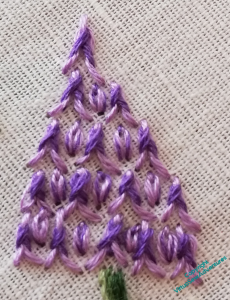
All that admitted, I felt I’d ended up with too great a space between the stitches, and of course, I don’t want to try to fit more in, in case I lose the ruffles (as it were!). So I have filled in the gaps with single detached chain stitches.
Of course, I may yet come back and do somethign entirely different. but I decided at this point to leave this in place and continue my experiments!
The next SlowTV Stitchery is now live. Episode 36 tackles the difficulties of the canvas, Reynard the Fox provides a distraction, and there is some tackling of quandaries by changing tack..

